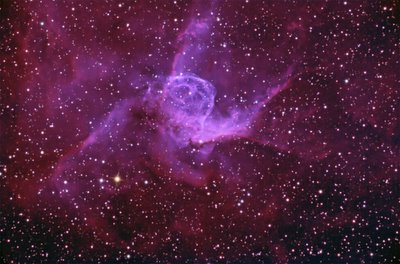Monday, February 06, 2006
Friday, February 03, 2006
Astronomy Picture of the Day

Cosmic Tornado HH49/50 Credit: J. Bally (Univ. of Colorado) et al., JPL-Caltech, NASA
Explanation: Light-years in length, this cosmic tornado is actually a powerful jet cataloged as HH (Herbig-Haro) 49/50 blasting down from the top of a Spitzer Space Telescope view. Though such energetic outflows are well known to be associated with the formation of young stars, the exact cause of the spiraling structures apparent in this case is still mysterious. The embryonic star responsible for the 100-kilometer per second jet is located just off the top of the picture, while the bright star seen near the tip of the jet may just by chance lie along the line of sight. In the false-color infrared image, the tornado glows with infrared light generated as the outflow heats surrounding dust clouds. The color coding shows a trend from red to blue hues at the tornado's tip indicating a systematic increase in emission at shorter wavelengths. The trend is thought to indicate an increase in molecular excitation closer to where the head of the jet is impacting interstellar gas. HH49/50 is about 450 light-years distant, located in the Chamaeleon I molecular cloud......Click on image to enlarge.....then click image on (bottom right icon that appears) to expand to high resolution.....If your not checking out these space pics in high res your missing out on lots of details.........
Thursday, February 02, 2006
Astronomy Picture of the Day
Explanation: Near picture center, the helmet-shaped structure with wing-like appendages is popularly called Thor's Helmet. Cataloged as NGC 2359, the striking nebula is located about 15,000 light-years away in the constellation Canis Major. The helmet is actually more like a cosmic bubble, blown as the wind from the bright, massive star near the bubble's center sweeps through the surrounding molecular cloud. Known as a Wolf-Rayet star, the energetic star is a blue giant thought to be in a brief, pre-supernova stage of evolution. The remarkable color composite combines broad and narrow band images including a deep exposure recorded with an H-alpha filter. The H-alpha image traces the light from the region's glowing atomic hydrogen gas. Heroically sized even for a Norse god, this Thor's Helmet is about 30 light-years across....Click on picture to enlarge........









